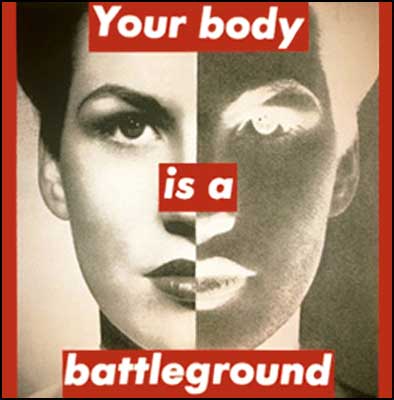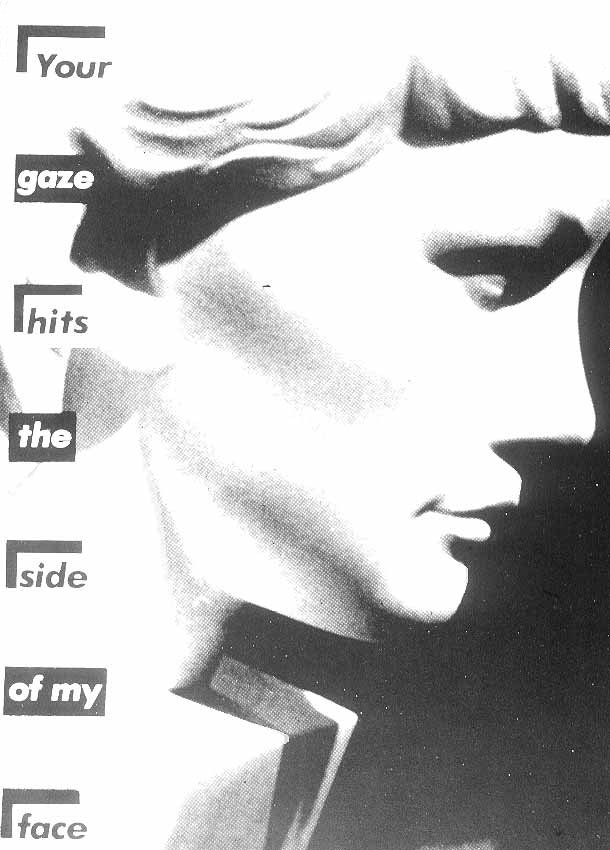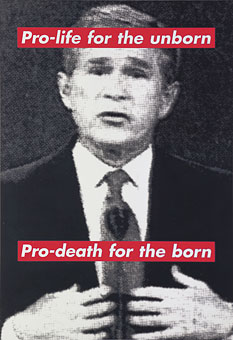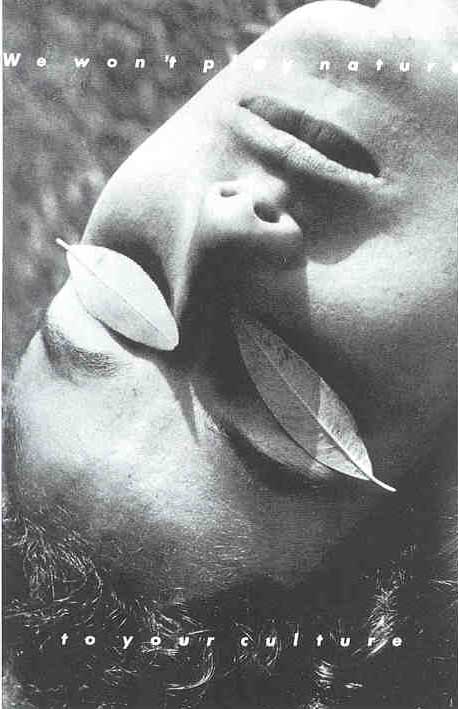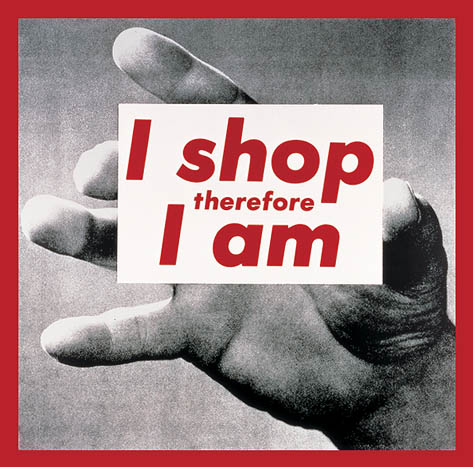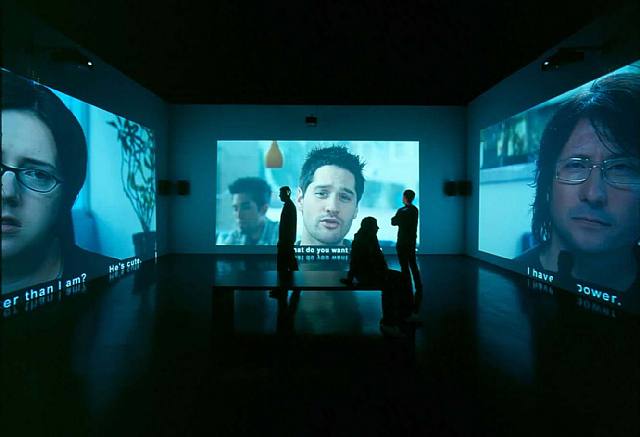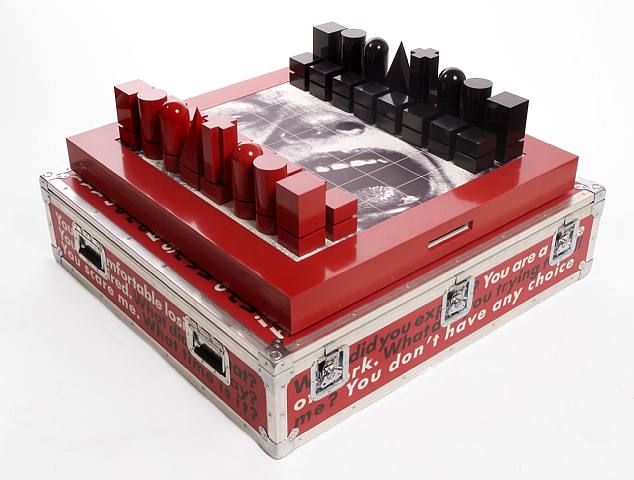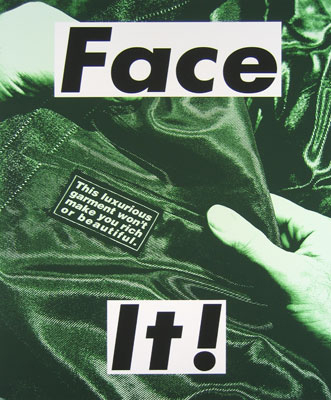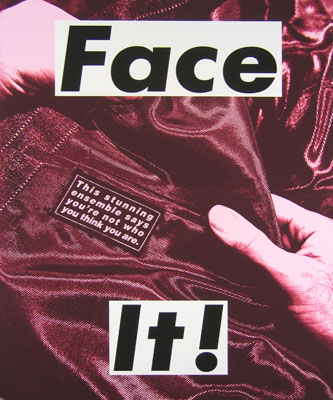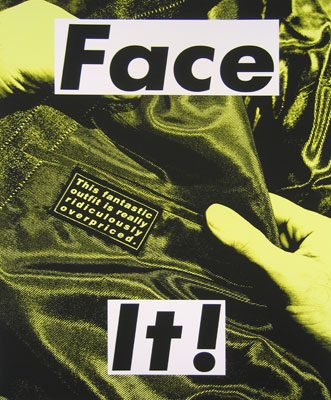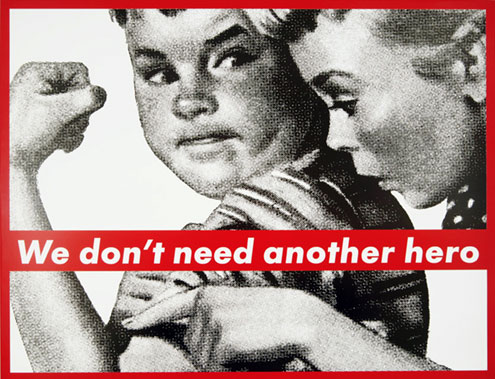| Barbara Kruger
The Art History Archive - Feminist Art
American conceptual/pop artist Barbara Kruger was born in Newark, New Jersey in 1945 and left there in 1964 to attend Syracuse University. Early on she developed an interest in graphic design, poetry, writing and attended poetry readings. After studying for a year at Syracuse she moved to New York where she began attending Parsons School of Design in 1965. She studied with fellow artists/photographers Diane Arbus and Marvin Israel, who introduced Kruger to other photographers and fashion/magazine sub-cultures. After a year at Parsons, Kruger again left school and worked at Condé Nast Publications in 1966. Not long after she started to work at Mademoiselle magazine as an entry-level designer, she was promoted to head designer a year later. Later still she worked as a graphic designer, art director, and picture editor in the art departments at “House and Garden”, “Aperture,” and did magazine layouts, book jacket designs, and freelance picture editing for other publications. Her decade of background in design is evident in the work for which she is now internationally renowned. Like Andy Warhol, Kruger was heavily influenced by her years working as a graphic designer.
Her ArtKruger’s earliest artworks date to 1969. Large woven wall hangings of yarn, beads, sequins, feathers, and ribbons, they exemplify the feminist recuperation of craft during this period. Despite her inclusion in the Whitney Biennial in 1973 and solo exhibitions at Artists Space and Fischbach Gallery, both in New York, the following two years, she was dissatisfied with her output and its detachment from her growing social and political concerns. In the fall of 1976, Kruger abandoned art making and moved to Berkeley, California, where she taught at the University of California for four years and steeped herself in the writings of Walter Benjamin and Roland Barthes. She took up photography in 1977, producing a series of black-and-white details of architectural exteriors paired with her own textual ruminations on the lives of those living inside. Published as an artist’s book, Picture/Readings (1979) foreshadows the aesthetic vocabulary Kruger developed in her mature work. By 1979 Barbara Kruger stopped taking photographs and began to employ found images in her art, mostly from mid-century American print-media sources, with words collaged directly over them. Her 1980 untitled piece commonly known as "Perfect" portrays the torso of a woman, hands clasped in prayer, evoking the Virgin Mary, the embodiment of submissive femininity; the word “perfect” is emblazoned along the lower edge of the image. These early collages in which Kruger deployed techniques she had perfected as a graphic designer, inaugurated the artist’s ongoing political, social, and especially feminist provocations and commentaries on religion, sex, racial and gender stereotypes, consumerism, corporate greed, and power.
During the early 1980s Barbara Kruger perfected a signature agitprop style, using cropped, large-scale, black-and-white photographic images juxtaposed with raucous, pithy, and often ironic aphorisms, printed in Futura Bold typeface against black, white, or deep red text bars. The inclusion of personal pronouns in works like Untitled (Your Gaze Hits the Side of My Face) (1981) and Untitled (I Shop Therefore I Am) (1987) implicates viewers by confounding any clear notion of who is speaking. These rigorously composed mature works function successfully on any scale. Their wide distribution—under the artist’s supervision—in the form of umbrellas, tote bags, postcards, mugs, T-shirts, posters, and so on, confuses the boundaries between art and commerce and calls attention to the role of the advertising in public debate. In recent years Barbara Kruger has extended her aesthetic project, creating public installations of her work in galleries, museums, municipal buildings, train stations, and parks, as well as on buses and billboards around the world. Walls, floors, and ceilings are covered with images and texts, which engulf and even assault the viewer. Since the late 1990s, Kruger has incorporated sculpture into her ongoing critique of modern American culture. Justice (1997), in white-painted fiberglass, depicts J. Edgar Hoover and Roy Cohn—two right-wing public figures who hid their homosexuality—in partial drag, kissing one another. In this kitsch send-up of commemorative statuary, Kruger highlights the conspiracy of silence that enabled these two men to accrue social and political power.
Art by Barbara Kruger
Sex / Lure - 1979
|
||
| ||
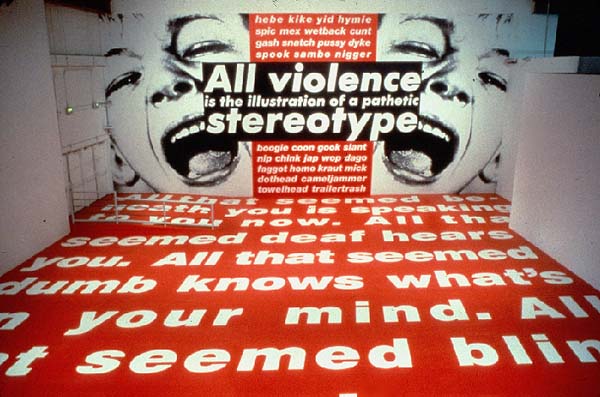
Her StyleBarbara Kruger's graphic work usually consists of black-and-white photographs with overlaid captions set in white-on-red Futura Bold Oblique. The phrases usually make a bold statement and commonly use pronouns such as you, I, your, we and they. She juxtaposes imagery with text containing criticism of sexism/misogyny and cultural power structures. Much of her text questions the viewer about feminism, classicism, consumerism, and individual autonomy and desire, although her black-and-white images are culled from the mainstream magazines that sell the very ideas she is disputing. She layers found photographs from existing sources with pithy and aggressive text that involves the viewer in the struggle for power and control that her captions speak to. In their trademark black letters against a slash of red background, some of her instantly recognizable slogans read “I shop therefore I am,” and “Your body is a battleground." Since her early years Barbara Kruger has also created installations comprised of video, film, audio and projection (she produced three large-scale gallery installations between 1989 and 1991). Enveloping the viewer with the seductions of direct address, her work is consistently about the kindnesses and brutalities of social life: about how we are to one another.
In these installation works Barbara Kruger transferred words and images directly to the surfaces of the gallery. Each installation featured a text written on the floor in white type on a red ground. Text reads: "All that seemed beneath you is speaking to you now. All that seemed deaf hears you. All that seemed dumb knows what's on your mind. All that seemed blind sees through you. All that seemed silent is putting the words right into your mouth." With a directness that is characteristic of Kruger's work, the text addresses the viewer's sense of certainty with the world. In Kruger's installations the floor now has a voice, the walls can hear you, and the architecture is manipulating the way you speak. At Kruger's self-titled exhibition at Mary Boone Gallery, this omnipresent, all-knowing and all-seeing surveillance was heightened by the way in which text appeared not only the floor but also on the walls and ceiling - enveloping the viewer. To walk into the room was to be addressed from all sides, left and right. While one read a text, other messages would be transmitted subliminally as one caught hold of a phrase or word in the corner of one's eye. Disrupting the seeming naturalness of the white gallery space, Kruger's treatment of the walls, floor, and ceiling underscored the way in which architecture and social spaces have their own way of speaking and representing the world.
"Kruger's works are direct and evoke an immediate response. Usually her style involves the cropping of a magazine or newspaper image enlarged in black and white. The enlargement of the image is done as crudely as possible to monumental proportions. A message is stenciled on the image, usually in white letters against a background of red. The text and image are unrelated in an effort to create anxiety by the audience that plays on the fears of society." - H.W./Anthony F Janson.
HonoursMajor solo exhibitions of Kruger’s work have been organized by the Institute of Contemporary Arts in London (1983), Museum of Contemporary Art in Los Angeles (1999), and Palazzo delle Papesse Centro Arte Contemporanea in Siena (2002). She represented the United States at the Venice Biennale in 1982. In 2005 Kruger was honored at the 51st Venice Biennale with the "Golden Lion" for Lifetime Achievement. Kruger is currently a professor at the University of California at Los Angeles. Barbara Kruger currently splits her time between New York and Los Angeles, where she lives and works.
Quotes by Barbara Kruger"I have no complaints, except for the world." - Barbara Kruger. "All the gossip and craziness becomes a kind of sustained narrative which, in turn, can become history. It's scary." - Barbara Kruger. "Although my art work was heavily informed by my design work on a formal and visual level, as regards meaning and content the two practices parted ways." - Barbara Kruger. "As with the Princess Di crash, which sent the media on the most insane feeding frenzy. From the moment of the crash, the pornography of sentiment never let up." - Barbara Kruger. "Direct address has been a consistent tactic in my work, regardless of the medium that I'm working in." - Barbara Kruger. "Do you know why language manifests itself the way it does in my work? It's because I understand short attention spans." - Barbara Kruger. "I don't necessarily think that installation is the only way to go. It's just a label for certain kinds of arrangements." - Barbara Kruger. "I feel uncomfortable with the term public art, because I'm not sure what it means. If it means what I think it does, then I don't do it. I'm not crazy about categories." - Barbara Kruger. "I had to figure out how to bring the world into my work." - Barbara Kruger. "I just say I'm an artist who works with pictures and words." - Barbara Kruger.
"I mean, making art is about objectifying your experience of the world, transforming the flow of moments into something visual, or textual, or musical, whatever. Art creates a kind of commentary." - Barbara Kruger. "I think I developed language skills to deal with threat. It's the girl thing to do-you know, instead of pulling out a gun." - Barbara Kruger. "I think people have to set up little battles. They have to demonize people whom they disagree with or feel threatened by. But it's the ideological framing of the debate that scares me." - Barbara Kruger. "I think that every so-called history book and film biography should be prefaced by the statement that what follows is the author's rendition of events and circumstances." - Barbara Kruger. "I think there are different ways of being rigorous, and I am asking people to be as rigorous in their pleasure as in their criticism." - Barbara Kruger. "I think there are lots of ways to make good work. You can throw big bucks at a project and make what some would call crap, or you can work very modestly with eloquently moving results." - Barbara Kruger. "I think what I'm trying to do is create moments of recognition. To try to detonate some kind of feeling or understanding of lived experience." - Barbara Kruger. "I try to deal with the complexities of power and social life, but as far as the visual presentation goes I purposely avoid a high degree of difficulty." - Barbara Kruger. "I want people to be drawn into the space of the work. And a lot of people are like me in that they have relatively short attention spans. So I shoot for the window of opportunity." - Barbara Kruger. "I'd always been a news junkie, always read lots of newspapers and watched the Sunday morning news shows on TV and felt strongly about issues of power, control, sexuality and race." - Barbara Kruger.
"I'm an artist who works with pictures and words. Sometimes that stuff ends up in different kinds of sites and contexts which determine what it means and looks like." - Barbara Kruger. "I'm living my life, not buying a lifestyle." - Barbara Kruger. "I'm trying to deal with ideas about histories, fame, hearsay, and how public identities are constructed." - Barbara Kruger. "I've always thought that it's good to watch the news to find out what everybody else is looking at and believing, if only because that's how consensus is constructed." - Barbara Kruger. "If most American cities are about the consumption of culture, Los Angeles and New York are about the production of culture - not only national culture but global culture." - Barbara Kruger. "It's good to keep in mind that prominence is always a mix of hard work, eloquence in your practice, good timing and fortuitous social relations. Everything can't be personalized." - Barbara Kruger. "Listen: our culture is saturated with irony whether we know it or not." - Barbara Kruger. "Look, we're all saddled with things that make us better or worse. This world is a crazy place, and I've chosen to make my work about that insanity." - Barbara Kruger. "Prominence is cool, but when the delusion kicks in it can be a drag. Especially if you choose to surround yourself with friends and not acolytes." - Barbara Kruger.
"There are so many moments and works that influence us in what we do. Movies, music, TV and, most importantly, the profound everydayness of our lives." - Barbara Kruger. "There's a moment of recognition. It's that white-light kind of stuff that just "works." I love that. And you know it when it happens, whether it's a movie, music, a building, a book." - Barbara Kruger. "Things change and work changes. Right now I like the idea of enveloping a space and getting messages across that connect to the world in ways that seem familiar but are different." - Barbara Kruger. "Warhol's images made sense to me, although I knew nothing at the time of his background in commercial art. To be honest, I didn't think about him a hell of a lot." - Barbara Kruger. "What makes the production of my work so expensive? The whole installation thing - the construction, the objects, the technology. It really adds up." - Barbara Kruger. "You know, one of the only times I ever wrote about art was the obituary of Warhol that I did for the Village Voice." - Barbara Kruger.
| ||
